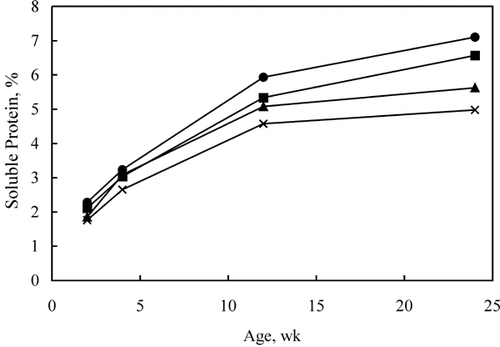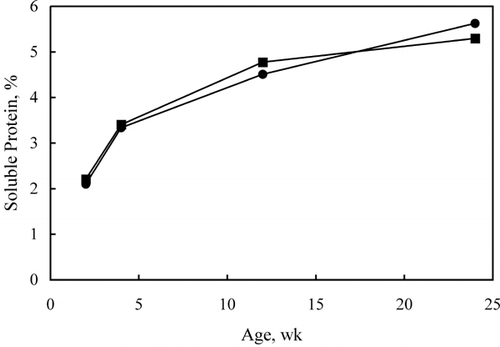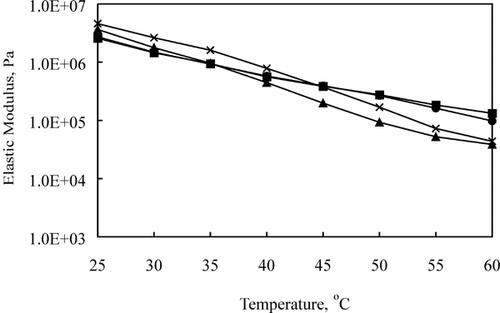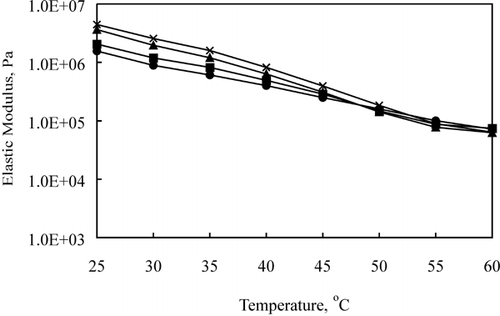Abstract
Rheological properties of different Cheddar cheeses were characterized using a dynamic test. Cheddar cheeses with four fat contents (15.3, 22.8, 37.3, and 45.6% fat in the dry matter—FDM) and two moisture contents (58.1 and 62.4% moisture in non fat portion—MNFP) at 2, 4, 12, and 24 wk old were used in this study. Time sweep mode was used to characterize the elastic (G ′) and viscous (G ″) properties of Cheddar cheese at a constant frequency of 1 Hz and strain 0.5%. G ′ and G ″ of the cheese were determined during heating from 25 to 60°C and cooling from 60 to 25°C. G ′ decreased from 9.0 to 0.07 MPa during heating and increased from 0.07 to 9.0 MPa during cooling of Cheddar cheese. G ″ showed similar trend as that of G ′ although magnitude of change were about one log higher. The reduction in % FDM of Cheddar cheese increased G ′ from 5.5 to 9.0 MPa and increased G ″ from 2.5 to 6.0 MPa at 25°C. A similar trend was observed at other temperatures. Proteolysis during ripening of cheese lead to decrease in G ′ and G ″ value for different fat Cheddar cheese at 60°C but differences were not statistically significant at 25°C. However, G ′ increased for high moisture Cheddar cheese (62.4% MNFP) from 1.6 to 4.4 MPa at 25°C and difference were not significant at 60°C.
Keywords:
Introduction
Use of cheese as an ingredient in prepared foods is increasing. Cheese plays an increasingly important role in adding taste, texture, and nutritional qualities to several prepared foods. A recent survey showed that 421 new cheeses were introduced in 1996, up 70% from 1995.Citation[1] The world cheese production increased by 9% between 1987 and 1996 with production in North America increased by 25%.Citation[2] Substantial amount of these cheeses are used in prepared foods as an ingredient. Concomitant with this is an increased need for characterizing the behavior of cheeses during heating and cooling.
Cheese is viscoelastic in nature and exhibits both solid (elastic) and liquid (viscous) behavior. Cheese consists of a continuous protein matrix with a loose and open structure with dispersed fat globules. The nature of the network mostly determines rheological and fracture properties. As fat content decreases the protein matrix becomes more compact with less open spaces thus affecting texture.Citation[3] The fat is solid at low temperatures, which corresponds to extensive cross‐linking of casein matrix. The fat act as rigid filler, but liquefies over essentially the same temperature range that the casein network dissociates, thus diluting or plasticizing the viscoelastic melt.Citation[4] Increasing moisture is generally recommended to help improve texture of the reduced‐fat cheeses.
Viscoelastic (rheological) properties such as elastic modulus (G ′) and viscous modulus (G ″) were used to characterize the textural changes due to different processing parameters and can be related to the nature of the cheese through analogous mechanical models. The elastic modulus of a given material is a measure of energy stored and recovered per cycle and the loss modulus is a measure of energy dissipated or lost as heat during a test cycle.Citation[5] Small deformation dynamic rheological testing has many applications in the food industry and has been applied to cheese. Various authorsCitation6–14 characterized the rheological properties of cheeses using small deformation dynamic tests. A dynamic rheological approach was applied by Taneya et al.Citation[6] to quantitatively study the dynamic properties of Gouda and Cheddar cheeses at temperature between −5 and 90°C and as function of aging. Gouda (soft) cheese had lower magnitude of G ′ than Cheddar (hard) cheese. Nolan et al.Citation[7] studied the dynamic shear modulus and viscoelasticities of natural Low Moisture Part Skim (LMPS) Mozzarella and imitation Mozzarella. In their study, they distinguished between imitation and natural Mozzarella cheese using dynamic properties of cheeses.
Tunick et al.Citation[8] examined viscoelastic properties of Cheddar and Cheshire cheeses using dynamic strain sweep test and suggested that viscoelastic properties could be used in identification of the two cheeses to prevent mislabeling. Hsiesch et al. Citation[9] made dynamic measurements to evaluate the effect of temperature (10–60°C) on melting properties of Mozzarella cheese. Ustunol et al.Citation[10] used dynamic rheological properties as index of meltability of cheddar cheese with varying fat content. They reported a significant correlation between dynamic complex modulus and meltability determined by traditional melt test known as Arnott test. In the Arnott test, a disk cheese specimen (22 mm in diameter and 17 mm in height) placed in a glass Petri dish was heated in an oven at 100°C for 15 min. After cooling to room temperature for 30 min, the height and diameter of the melted cheese were measured and used as a meltability of the cheese. Ustunol et al.Citation[11] employed dynamic rheological testing to study the influence of fat reduction on the rheological properties of Cheddar cheese from 30 to 70°C. They observed that fat reduction in Cheddar cheese resulted in an increase in viscoelasticity as evidence by increases in G ′ and G ″.
All of the studies reported in the literature have focused on evaluating the rheological properties of cheeses at refrigeration temperature or during heating. It is also important to evaluate the viscoelastic properties of cheese during cooling since the consumer eats cheese after it gets melted and cooled. The attributes during cooling are important because by the time the melted cheese is served to consumer, it may become harder and may not be acceptable for consumers. Our objectives of this study were to characterize the rheological properties (G ′ and G ″) of Cheddar cheeses using small deformations dynamic tests, and to study the effect of fat content; moisture content, cheese heating and cooling temperature, and ripening of cheese on the G ′ and G ″. This should provide insight into the effects of heating, cooling, composition, and ripening on rheology of cheese and thus aid in development of cheeses for ingredient applications.
Materials and Methods
Cheese Manufacture
Cheddar cheese with varying fat contents [45.6, 37.3, 28.4, and 15.3% fat‐in‐dry matter (FDM) and constant moisture‐in‐non‐fat portion (MNFP) ∼50%] was manufactured from milk standardized to 3.5, 2.2, 1.1, and 0.5% fat levels. Standardized milk (∼91 kg) was warmed to 32°C and inoculated with 0.02% DVS (Direct Vat Set) culture (DVS #M46, Rhodia, Inc., Madison, WI). Milk was ripened for 1 hr, and 0.01% chymosin (Chymosin Classic, Rhodia, Inc., Madison, WI) was added to clot the milk for 30 min. Cheddar cheese was manufactured by the standard procedure outlined by KosikowskiCitation[15] in the Dairy plant of the Dairy Science Department at South Dakota State University. Curd was salted, hooped, and pressed for 6 h. Manufactured cheeses were vacuum‐packaged the next day and ripened in a refrigerator (∼6–8°C) for 2, 4, 12, and 24 wk.
Cheddar cheese with varying moisture contents (58.1 and 62.4% MNFP and constant FDM ∼52%) was manufactured from the milk standardized to 3.5% fat level. For making the milled curd normal Cheddar cheese, 114 kg milk was taken into the vat, warmed to 32°C and 21 mL starter (Chr. Hansen DVS 970) was added. After 45 min of ripening annatto color‐double strength (@1.25 oz/1000 lbs.), calcium chloride (@3 oz/1000 lbs.) and chymosin (Chy max II, double strength @1.15 oz/1000 lbs.) were added in sequence to the milk. The curd was cut at desired firmness (after almost 25 min) using 1/4″ knives and to achieve 38°C temperature within 30 min. The whey draining was carried out at curd pH of 6.25 followed by cheddarring till pH 5.55 (almost 1.45 h) and milling. The milled curd was salted using dry flake salt (@0.31% w/w of milk) and pressed for 4 h.
High moisture milled curd Cheddar cheese was manufactured by allowing less time for ripening the milk (30 min vs. 45 min), making bigger size of curd cubes (3/8″ vs.1/4″ knives), early draining of whey (at curd pH 6.35 vs. 6.25), early milling of the curd (at pH 5.85 vs. 5.55), lowering rate of salting (255 g vs. 352 g/250 lbs. milk), and longer pressing (30 min more) than normal cheese. Cheddar cheese with varying moisture contents was manufactured in the Dairy plant of the Food Science Department at University of Wisconsin—Madison and shipped overnight to South Dakota State University for testing. Cheese blocks were vacuum‐sealed in barrier bags and ripened in a refrigerator (∼6–8°C) for 2, 4, 12, and 24 wk.
Chemical Analysis of Cheese
Fat content was determined using Modified Mojonnier Ether Extraction Method (No. 933.05) as described in the Association of Official Analytical Chemists (AOAC, 1997).Citation[16] Protein concentration was determined by the Kjeldahl method (No. 920.123), as described in the AOAC.Citation[16] Moisture content of the cheese was determined with a moisture balance (Model MB200; Ohaus Corp., Florham Park, NJ) as described by Crosser and Mistry.Citation[17] Ash content was determined by heating in a muffle furnace at 535°C as outlined (Method No. 935.42) by the AOAC.Citation[16] Soluble protein in cheese was determined by the macro‐Kjeldahl method after extracting it with Sharpe's extract.Citation[16] The salt contentCitation[18] of the cheese was determined using a sodium electrode attached to an ion analyzer (Model 150, Corning Medical, Medfield, MA).
Dynamic Rheology
Sample Preparation
In order to obtain samples of uniform shapeCitation[19] cheeses were cut at refrigerated temperature (10°C) into thin slices (∼3.6 mm thick) using a food slicer (Model MS1043‐W, The Rival Co., Kansas, MO). Then disk specimens of 20.4 mm in diameter were cut out with a cork borer. The cut cheese sample were packed into plastic bags and placed in the refrigerator (4–6°C) before testing.
Dynamic Testing
A Haake® rheometer (Model CV20, Haake Mess‐Technik GmbH u. Co., Dieselstr, Germany) was used to characterize the rheological properties of cheese samples. Control system RV20 was used to control shear rate and control system RC20 was used to control amplitude and frequency. CV20 sensor system with Q20 sensor was used to measure the dynamic rheological properties of the cheese. For heating and cooling the cheese, the sensor system was connected to Haake® circulator. The circulator is a combination of heating bath, circulator, and refrigerating bath. To enhance the heating rate, an external heater (Model 742G, Allied precision Ind. Elburn, IL) was used. From the preliminary runs, it was observed that the heating rate was consistent among four runs. The changes in cheese temperature, water bath temperature with time during heating and cooling was recorded and calibrated. The temperature change during heating and cooling of cheese was monitored using copper‐constantan precision fine thermocouple of 0.043 and 0.071 mm diameter that was inserted at the geometric center of cheese. The purpose of calibrating cheese temperature variation during heating and cooling before actual sample test aids in two ways. First, if we use an in‐build temperature sensors, it measures the upper surface temperature of cheese and not the center temperature. Second, due to heating of cheese at higher temperature, the thermocouple may be dislocated from its actual position on the surface, since cheese is constantly subjected to oscillatory strain. A personal computer with software (Haake® Software, Rotovisco RV20, Oscillation, Version 2.23) was used for data collection and analysis.
The tests were performed by placing the disk specimen (∼3.6 mm thick and 20.8 mm dia) between the parallel plate fixtures (3.5 mm thick and 20.4 mm dia) of CV20 sensor system at a constant frequency of 1 Hz. The peripheral surface of the cheese was oiled to avoid loss of moisture during heating. From our preliminary experiments, it was observed that the testing time doesn't affect the storage and viscous modulus of cheese, hence, we used time sweep mode to measure rheological properties of cheese. Plot of complex modulus vs. strain from published resultsCitation[12] and our preliminary trials showed a linear behavior up to 0.5% strain. Therefore, we used a constant stain of 0.5% for testing cheese.
Before starting the experiment, the water bath temperature was maintained at 25°C for 10 min, so that the cheese temperature between the plates would reach 25°C. Once the sample attained the initial test temperature, the data acquisition system and heating system were started simultaneously. After cheese temperature reached 60°C, heating system was turned off and cooling system was switched on until the completion of the experiment. On the basis of preliminary experiments, following conditions were chosen to study the effect of temperature on the rheological properties of cheeses. Cheese temperature was raised from 25 to 60°C at 1°C/min during heating test and decreased from 60 to 25°C at 1°C/min during cooling test. Rheological data collection includes elastic modulus (G ′, Pa) and tangent (tan δ, dimensionless). Viscous modulus (G ″, Pa) was computed using the relation G ″ = G ′ tan δ.
Statistical Analysis
The cheese manufacturing was replicated three times in a randomized block design. G ′ and G ″ values of 144 sub batches (4 fat × 3 replications × 4 aging × 3 samples) and 72 sub batches (2 moisture × 3 replications × 4 aging × 3 samples) at different temperature were used for analysis of data. Mean square values were determined using the General Linear Model procedure on the SAS Statistical software packageCitation[20] and appropriate comparisons were made for different fat levels and moisture levels at specified temperatures during heating and cooling. An interaction is described to be significant only when P < 0.05. Variation among samples within particular interaction term to be tested was used as the error term to eliminate its source of variance.
Results and Discussion
Cheese Composition
Mean values of the composition analysis of four different fat Cheddar cheeses are shown in . The moisture, salt and protein content of cheese increased with decreased fat content. It is very difficult to study the effect of individual factors such as fat and moisture level on the rheological properties of cheese, since changes in one factor automatically change the values of the other components. The MNFP remains almost same for different fat content cheeses, where as the FDM tends to decrease as fat content decreased. This MNFP and FDM variation for different cheeses is termed as an effect of reduction in fat content of cheese. When these factors on their own have an opposite effect on cheese rheological properties the combined influence may lead to conflicting results. Mean values of Cheddar cheeses with different moisture contents are also shown in . The MNFP increased as moisture content increased, but the FDM remained the same. This MNFP and FDM variation for different cheese is termed as an effect of increase in moisture content of cheese. However, the salt and protein content of cheese decreased with increased moisture content.
Table 1. Chemical composition of cheeses used in this study
Solubility Test
The percentage of soluble protein during aging of four different %FDM Cheddar cheeses is shown in . The soluble protein increased significantly (P < 0.05) due to aging and the differences among different cheeses were statistically significant at each aging time. The increase for low fat (15.3% FDM) cheese was greater as compared to high fat (45.6% FDM) cheese. These results are in good agreement with results reported by Ustunol et al.Citation[11] They reported a three to four fold increase in % soluble protein from day 1 to 3 month of ripening for different fat Cheddar cheese. We observed a three‐fold increase in % soluble protein from wk 2 to 12 of aging for different %FDM Cheddar cheeses. The percentage of soluble protein during aging for two moisture levels Cheddar cheeses is shown in . The soluble protein increased significantly due to aging of the two moisture level Cheddar cheeses and differences between the two moisture cheeses during aging were not significantly different.
Effect of Fat and Aging on Elastic and Viscous Modulus of Cheddar Cheeses
Effect of Fat
The interaction effect of temperature by fat by aging was not significant (P < 0.05) for G ′ value. However, due to the heterogeneity of error variance between the aging time and the fat content, the temperature, fat and aging interaction could not be evaluated with statistical merit.Citation[21] The assumption of a sorting procedure in statistics requires a homogeneity of error variance, which was not observed for this data. There was more variation between cheeses within replication than aging. This variation between cheeses also increased with storage time. G ′ values were sorted for each age and temperature to discern trends among fat and were sorted for each fat and temperature to discern trends among ages.
The error variation occurred within each sample were different at each temperature, age, and fat content of cheese sample. Overall, we observed an error variation of 5 to 10% within each sample. The effect of heating cheese from 25 to 60°C and cooling from 60 to 25°C on G ′ value of four different %FDM Cheddar cheeses are shown in . The G ′ of all cheeses decreased (P < 0.05) steadily with increasing temperature during heating. Overall, G ′ increased (P < 0.05) with decrease in %FDM during heating. Although the G ′ of the cheeses were not different at the initial 25°C, as the temperature increased to 60°C, G ′ became distinctly different by more than one log cycle. However, the decrease in G ′ for high fat cheeses (37.3 and 45.6% FDM) were steeper than that of low fat cheeses (15.3 and 28.4% FDM). This indicated that the change in elastic behavior of reduced‐fat Cheddar cheese was only minimal upon heating. As fat content decreases, the protein matrix become more compact with less open spaces thus affecting the elastic component of the cheese during heating. Ustunol et al.Citation[11] observed a similar behavior in their study when evaluating the viscoelastic of behavior of different fat Cheddar cheeses. However, their G ′ values were three log lower than the values we observed in this study. For example, they reported that the value of G ′ decreased from 0.01 to 0.001 MPa for different fat Cheddar cheese when heated from 30 to 70°C. However, G ′ values observed in this study decreased from 9.0 to 0.07 MPa during heating from 25 to 60°C and increased to 17 MPa during cooling from 60°C to 25°C for different fat Cheddar cheese. This may be because of the larger strain (0.5%) value, different sample size, and cheese making procedure used in our study compared to their study.
Figure 3. Effect of fat (◊: 15.3%, □: 28.4%, ▵: 37.3%, ○: 45.6% FDM) on the elastic modulus (G ′) for 2‐wk‐old Cheddar cheese during heating and cooling (open symbols = heading and solid symbols = cooling).

The G ′ of different fat content Cheddar cheese increased (P < 0.05) steadily during cooling from 60°C to 25°C. Overall, the G ′ value of (15.3 and 28.4% FDM) Cheddar cheese during cooling was higher (P < 0.05) than that of same cheese during heating. This behavior shows that the reduced‐fat Cheddar cheeses become harder during cooling from 60°C to 25°C. However, we observed that the G ′ value of high fat Cheddar cheese (45.6% FDM) during cooling cross over with G ′ value of same cheese during heating. And the G ′ value of 45.6% FDM cooled cheese at 25°C was less than that of unmelted cheese at 25°C. This suggests that the cooled high fat cheese is less elastic than that of unmelted cheese at 25°C. Comparing heating and cooling process, it is evident that the cheese microstructure goes through an irreversible process during heating thus affecting the cheese behavior during cooling. This phenomena needs to be further investigated by carefully studying the changes in cheese microstructure during heating and cooling. The 45.6% FDM cheese had the lowest G ′ and the 15.3% FDM cheese had the highest G ′ (upon cooling to 25°C) suggesting that reduction in fat resulted in an increase in elastic character of Cheddar cheese () during cooling.
Changes in G ″ of the cheeses during heating to 60°C followed a similar trend as that of G ′ although magnitudes of changes were larger. At any temperature, G ′ () was greater than G ″ () which indicates that the elastic component contributed more to viscoelasticity than the viscous component. The high fat cheese (45.6% FDM) decreased with steeper slope than low fat cheese (15.3% FDM) as shown in during heating. Overall, G ″ increased (P < 0.05) with decrease in %FDM during heating. This indicates that all the cheeses undergo changes in viscous properties upon heating. This finding is in contrast to the results reported by Ustunol et al.Citation[11] that reduced‐fat cheeses do not undergo changes in viscous properties upon heating. At this time we cannot explain these discrepancies. Overall, fat reduction in Cheddar cheese resulted in an increase in viscoelasticity as evidenced by increase in G ′ and G ″.Citation[12]
Figure 4. Effect of fat (◊: 15.3%, □: 28.4%, ▵: 37.3%, ○: 45.6% FDM) on the viscous modulus (G ″) for 2‐wk‐old Cheddar cheese during heating and cooling (open symbols = heating and solid symbols = cooling).
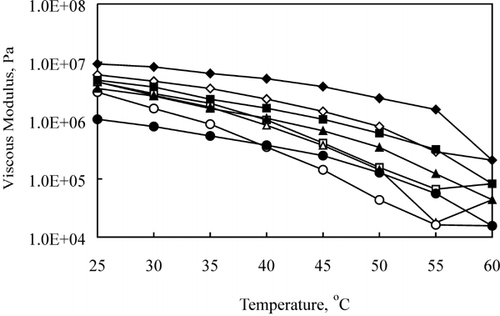
Changes in G ″ of the cheeses during cooling to 25°C followed a similar trend as of G ′ although magnitudes of changes were larger. Additionally, the changes in G ″ of the cheeses during heating from 45 to 60°C and cooling from 60 to 45°C were quite different () comparing the changes in G ′ in that temperature range (). However, we didn't observe any cross over of G ″ with G ′. But, Zhou and MulvaneyCitation[4] observed that G ′ and G ″ crossed over each other in the temperature range of 45°C to 65°C when they investigated the effect of milk fat, the ratio of casein/water, and temperature on the viscoelastic properties of rennet casein gels. It appears that there was some significant differences in G ′ and G ″ during heating and cooling which was affected by the amount of fat and the ratio of protein and water present in the cheese.
Effect of Aging
The degree of proteolysis during the ripening period contributes to softening of cheese because products formed due to casein breakdown are water‐soluble and cannot contribute to the framework provided by the protein matrix. Percentage of soluble protein formed increased from 2.3 to 7% in 15.3% FDM Cheddar cheese whereas it increased from 2 to 4.5% in 45.6% FDM Cheddar cheese due to aging from 2 to 24 wk (). Loss of the protein network by proteolysis implies a decrease in G ′. We observed this behavior while testing aging characteristics of Cheddar cheeses and the results are shown in for 45.6% FDM Cheddar cheese during heating. A similar trend was observed during cooling tests. At the same time we expected an increase in viscous contribution but it was not observed. This was probably related to the fact that proteolysis generates ionic groupsCitation[22] that bind water and that would consequently reduce viscous dissipation. Hence, G ″ decreased over storage time for 45.6% FDM Cheddar cheese as shown in . A similar trend was observed for all other Cheddar cheeses with different %FDM during heating and cooling.
Figure 5. Effect of aging (•: 2, ▪: 4, ▴: 12, × : 24 wk) on elastic modulus (G ′) of 45.6% FDM Cheddar cheese during heating.
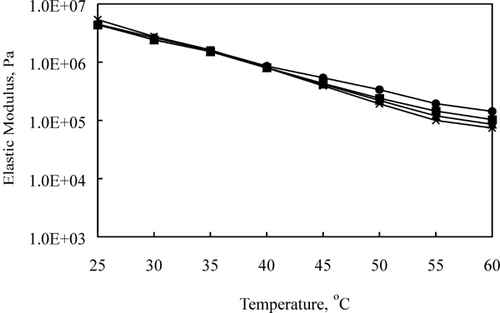
Figure 6. Effect of aging (•: 2, ▪: 4, ▴: 12, × : 24 wk) on viscous modulus (G ″) of 45.6% FDM Cheddar cheese during heating.
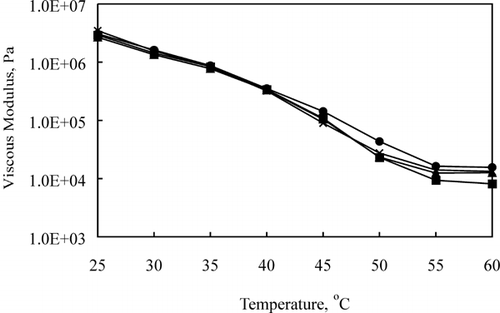
Nolan et al.Citation[7] reported that the protein network structure was responsible for making cheese viscoelastic. As in the case of milk gels,Citation[23] it is likely that degradation products from casein hydrolysis contributed less to the moduli of the cheese as compared as intact casein. Our results indicated that G ′ and G ″ of Cheddar cheese of different fat levels decreased during ripening indicating a loss of protein network due to proteolysis.
At the beginning of storage, the proteins tend to maintain a strong protein‐to‐protein interactions and have high G ′ values even though expressible water and fat are present within the fat channels. Soluble protein that results due to aging of cheese is more hydrophobicCitation[24] in nature. Due to this hydrophobic nature of protein due to aging, it is possible that the moisture might be migrated from the fat channels into the protein matrix. This makes the protein become more hydrated. Hence, it allows the proteins to weaken its structure when heated and resulted in less G ′ values.
Effect of Moisture and Aging on Elastic and Viscous Modulus of Cheddar Cheese
Effect of Moisture
The effect of heating cheese from 25 to 60°C and cooling from 60 to 25°C on G ′ value of two moisture Cheddar cheese of 2 wk old are shown in . The G ′ of all cheeses decreased steadily with increasing temperature during heating and increased steadily during cooling. The G ′ of high moisture cheese (62.4% MNFP) was significantly (P < 0.05) lesser than normal moisture cheese (58.1% MNFP) even though both cheese had the same FDM. This implies that higher moisture content made the cheese softer and less elastic compared to the normal moisture. This supported our hypothesis that cheese would become softer if its moisture content is elevated. Our results were in consistent with those of Luyten et al.Citation[25]
Figure 7. Effect of moisture (◊: 58.1%, □: 62.4% MNFP) on elastic modulus (G ′) Cheddar cheese during heating and cooling at 2‐wk aging (open symbols = heating and solid symbols = cooling).
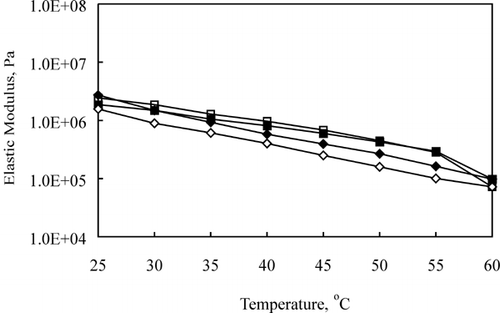
G ′ value of 58.1 and 62.4% MNFP Cheddar cheese increased (P < 0.05) steadily during cooling from 60°C to 25°C. The G ′ value of 62.4% MNFP Cheddar cheese during cooling was higher (P < 0.05) than that of same cheese during heating. This behavior shows that the higher moisture cheese become harder during cooling from 60°C to 25°C. However, we observed that the G ′ value of normal moisture cheese (58.1% MNFP) during cooling cross over with G ′ value of same cheese during heating at about 30°C. And the G ′ value of normal moisture cooled cheese at 25°C was less than that of unmelted cheese at 25°C. This suggests that normal moisture cooled cheese was less elastic than that of unmelted cheese at 25°C.
G ″ value of 58.1% and 62.4% MNFP Cheddar cheese during heating and cooling followed a similar trend as of G ′ although the magnitude of change was about one log higher. Moreover, the changes in G ″ of the cheeses during heating from 45 to 60°C and cooling from 60 to 45°C were quite different (data not presented) comparing the changes in G ′ in that temperature range. This behavior was similar to the observations made on G ″ values for varying %FDM Cheddar cheeses.
Effect of Aging
The G ′ value of normal moisture (58.1% MNFP) Cheddar cheese decreased during aging when the cheese was heated to 60°C; however, they increased (P < 0.05) as determined at 25°C as shown in . There was a cross over occurred among aged cheeses at about 40°C during heating. On the other hand, the ripening of cheese lead to increase in G ′ value of 62.4% MNFP Cheddar cheese as determined at 25°C and was not significantly different when cheese was heated to 60°C as shown in . Moisture to protein ratio (M:P) was higher in 62.4% MNFP Cheddar cheese (M:P = 1.92) compared to 58.1% MNFP Cheddar cheese (M:P = 1.62) and that might have affected the hydration property. Also, the proteolysis remained the same (). This all might have been responsible for the difference in G ′ values at lowcr temperature in high moisture cheese. Most of the milk fat melts at 42–45°C, at which point they are soft and we observed no significant difference in G ′ value above 45°C. Fat globules have a hydrophilic surface and they are non‐attractive to the protein matrix. Absorption of water from the fat channels into the soluble protein matrix allows re‐arrangement of proteins so that increase protein hydration occurs. Migration of moisture from fat to soluble protein may lead to the increased elastic nature of the fat component, as water is lost from it. This was evidenced by increase in G ′ value in high moisture cheese due to aging even though the % soluble protein formed for 62.4 and 58.1% MNFP Cheddar cheeses was not significantly different ().
The G ″ values showed a similar trend as that of G ′ values. At the same time, G ″ values at high temperatures were not significantly different since the G ″ values at 55°C were lower than that at 60°C. In matured cheese, there was no significant (P < 0.05) differences in G ′ values of the two different %MNFP cheese. This indicates that aging high moisture cheese does not improve the viscoelastic property of cheese as compared to young cheese of different moisture content with same FDM ( and ). It appears that the overall viscoelasticity of a Cheddar cheese can be considered as combined effects of fat content and the balance between protein‐to‐protein and protein‐to‐water interactions of the cheese matrix.
Conclusions
Rheological properties of Cheddar cheese changed as heated from 25 to 60°C, cooled from 60 to 25°C, fat content in the cheese reduced, moisture content increased, and ripened upto 24 wk. Heating of cheese resulted in decreasing viscoelastic properties as evidenced by decrease in G ′ and G ″. The viscoelastic properties of Cheddar cheeses increased due to cooling as evidenced by increase in G ′ and G ″ values. Overall, the viscoelastic properties of reduced‐fat Cheddar cheeses were significantly higher during cooling than during heating at each temperature. Fat reduction in Cheddar cheese resulted in an increase in an increase in viscoelasticity as evidenced by increase in G ′ and G ″. Addition of moisture improved the viscoelastic properties of cheese as evidenced by a decrease in G ′ and G ″. Cheddar cheese of different fat contents showed that G ′ values decreased significantly due to aging from 2 to 24 wk as determined at 60°C but were not significantly different at 25°C. Also, addition of moisture in cheese showed significant increase in G ′ and G ″ value due to aging from 2 to 24 wk as determined at 25°C but was not significantly different at 60°C. These characteristics may be important to the development of new cheeses for ingredient applications.
Acknowledgments
Published with the approval of director of the South Dakota Agricultural Experiment Station as Publication Number 3230 of the Journal Series. College of Agriculture and Biological Sciences at South Dakota State University supported this research, through funds from the Agricultural Experimental Station. The authors wish to thank Howard Bonnemann and John Jaeggi for assistance in cheesemaking and chemical analyses of cheeses.
| NOMENCLATURE | ||
| G ′ | = |
Elastic modulus, Pa |
| G ″ | = |
Viscous modulus, Pa |
| FDM | = |
Fat in the dry matter, % |
| MNFP | = |
Moisture in non fat portion, % |
References
- Friedman , M. 1997 . Deluge of dairy foods . Prepared Foods, New Food Products Annual. , 165 ( 5 ) : 65 – 66 .
- 1999 . Cheese Facts , 10 : 14 International Dairy Food Association Washington DC
- Bryant , A. , Ustunol , Z. and Steffe , J. 1995 . Texture of Cheddar cheese as influenced by fat reduction . J. Food Sci. , 60 ( 6 ) : 1217 – 1219 . 1236
- Zhou , N. and Mulvaney , S. J. 1998 . The effect of milk fat, the ratio of casein to water, and temperature on the viscoelastic properties of rennet casein gels . J. Dairy Sci. , 81 : 2561 – 2571 .
- Ferry , J. D. 1980 . Viscoelastic Properties of Polymers New York : J. Wiley and Sons, Inc. . 3rd Ed.
- Taneya , S. , Izutsu , T. and Sone , T. 1979 . “ Dynamic viscoelasticity of natural cheese and process cheese ” . In Food Texture and Rheology Edited by: Sherman , P. 153 – 167 . London : Academic Press .
- Nolan , E. J. , Holsinger , V. H. and Shieh , J. J. 1989 . Dynamic rheological properties of natural and imitation Mozzarella cheese . J. Texture Stud. , 20 : 179 – 189 .
- Tunick , M. H. , Nolan , E. J. , Shieh , J. J. , Basch , J. J. , Thompson , M. P. , Maleeff , B. E. and Holsinger , V. H. 1990 . Cheddar and Cheshire cheese rheology . J. Dairy Sci. , 73 : 1671 – 1675 .
- Hsiesch , Y. I. , Yun , J. J. and Rap , M. A. 1993 . Rheological properties of Mozzarella cheese filled with dairy, egg, soy proteins, and gelatin . J. Food Sci. , 58 ( 5 ) : 1001 – 1004 .
- Ustunol , Z. , Kawachi , K. and Steffe , J. 1994 . Arnott test correlates with dynamic rheological properties for determining Cheddar cheese meltability . J. Food Sci. , 59 ( 5 ) : 970 – 971 .
- Ustunol , Z. , Kawachi , K. and Steffe , J. 1995 . Rheological properties of Cheddar cheese as influenced by fat reduction and ripening time . J. Food Sci. , 60 ( 6 ) : 1208 – 1210 .
- Ak , M. M. and Gunasekaran , S. 1996 . Dynamic rheological properties of Mozzarella cheese during refrigeration storage . J. Food Sci. , 61 : 566 – 568 .
- Subramanian , R. and Gunasekaran , S. 1997a . Small amplitude oscillatory shear studies on Mozzarella cheese. I. Region of linear viscoelasticity . J. Texture Stud. , 28 ( 6 ) : 633 – 642 .
- Subramanian , R. and Gunasekaran , S. 1997b . Small amplitude oscillatory shear studies on Mozzarella cheese. II Relaxation spectrum . J. Texture Stud. , 28 ( 6 ) : 643 – 656 .
- Kosikowski , F. V. and Mistry , V. V. 1997 . “ Analysis ” . In Cheese and Fermented Milk Foods, Vol. II Procedures and Analysis 259 – 260 . Westport , CT : F. V. Kosikowski L.L.C. . 3rd Ed.
- 1997 . “ Association of Official Analytical Chemists ” . In Official Methods of Analysis 58 – 63 . Arlington , VA : AOAC Int. . 16th Ed.
- Crosser , A. E. and Mistry , V. V. 1991 . Use of a moisture balance to determine moisture of cheese . J. Dairy Sci. , 74 ( Suppl. 1 ) : 126 (Abstr)
- Kindstedt , P. S. and Kosikowski , F. V. 1984 . Measurement of sodium chloride in cheese by a simple sodium ion electrode method . J. Dairy Sci. , 67 : 879 – 883 .
- Casiraghi , E. M. , Bagley , E. B. and Christianson , D. D. 1985 . Behavior of Mozzarella, Cheddar and processed cheese spread in lubricated and bonded uniaxial compression . J. Texture Stud. , 16 : 281 – 301 .
- 1999 . “ SAS/STAT ” . In Guide for Personal Computers, Version. 6 Cary , NC : SAS Institute Inc. . 12th Ed.
- Steel , R. G. and Torrie , J. H. 1980 . “ A biometrical aroach ” . In Principles and Procedures of Statistics 233 – 234 . New York : McGraw‐Hill . 2nd Ed.
- Creamer , L. K. and Olson , N. F. 1982 . Rheological evaluation of maturing Cheddar cheese . J. Food Sci. , 47 ( 2 ) : 631 – 636 . 646
- Zoon , P. , Roefs , S. P.F.M. , De Cindio , B. and Van Vlient , T. 1990 . Rheological properties of skim gels at various temperatures; interrelation between the dynamic moduli and the relaxation modulus . Rheol. Acta. , 29 : 223 – 230 .
- McMahan , D. C. , Fife , R. L. and Oberg , C. J. 1999 . Water partitioning in Mozzarella cheese and its relationship to cheese meltability . J. Dairy Sci. , 82 : 1361 – 1369 .
- Luyten , H. , Van Vliet , T. and Walstra , P. 1991 . Characterization of the consistency of Gouda cheese: rheological properties . Neth. Milk Dairy J. , 45 : 133 – 153 .
